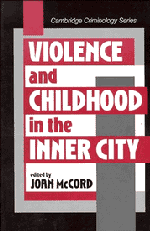Book contents
- Frontmatter
- Contents
- List of Contributors
- Preface
- 1 Violence and the Inner-City Street Code
- 2 The Embeddedness of Child and Adolescent Development
- 3 Placing American Urban Violence in Context
- 4 Neuropsychology, Antisocial Behavior, and Neighborhood Context
- 5 Psychological Mediators of Violence in Urban Youth
- 6 Understanding and Preventing Child Abuse in Urban Settings
- 7 Intervening to Prevent Childhood Aggression in the Inner City
- Name Index
- Subject Index
6 - Understanding and Preventing Child Abuse in Urban Settings
Published online by Cambridge University Press: 01 June 2011
- Frontmatter
- Contents
- List of Contributors
- Preface
- 1 Violence and the Inner-City Street Code
- 2 The Embeddedness of Child and Adolescent Development
- 3 Placing American Urban Violence in Context
- 4 Neuropsychology, Antisocial Behavior, and Neighborhood Context
- 5 Psychological Mediators of Violence in Urban Youth
- 6 Understanding and Preventing Child Abuse in Urban Settings
- 7 Intervening to Prevent Childhood Aggression in the Inner City
- Name Index
- Subject Index
Summary
Introduction
Of all forms of violence, child abuse is the most invidious. At once, it demands an immediate response and introduces its victims to one loop in a spiral of aggression and violence linking generations. The dependent status of children requires society to intervene in a manner unlike that for other forms of violence. However, a dilemma exists. The dilemma is portrayed in its starkest (and commonest) form when the abuser is a parent. We ask, “Is it necessary to protect the child by removal from the primary source of support and care, or can the family be spared this fracture and undergo needed repair with the child present?” More fundamentally, the question is, “When does the positive freedom of the child to develop normally supersede the negative freedom of the family to socialize the child?” Unfortunately, the roles of law, social welfare, and health care are complex, imprecise, and often at odds. We aim to show in this paper that the balance between children's rights and the integrity of the family as the most basic unit of socialization is upset in the context of urban poverty and social disorganization. Of fundamental importance in efforts to control violence against children is the need to reverse the trend toward deteriorating urban environments. Our focus on the topic of child abuse underscores this reality.
Children who are victims of violence and neglect are more likely to behave in aggressive ways with their peers, and as they mature, they are likely to become abusive and violent with their own children.
- Type
- Chapter
- Information
- Violence and Childhood in the Inner City , pp. 207 - 255Publisher: Cambridge University PressPrint publication year: 1997



